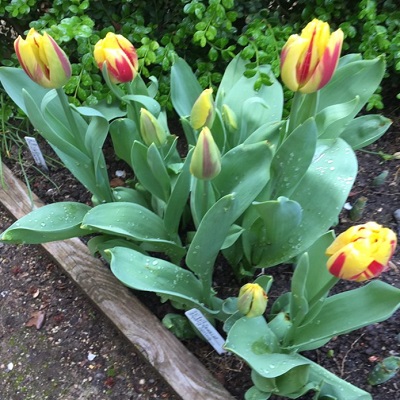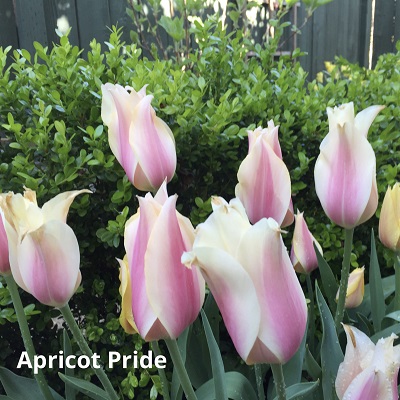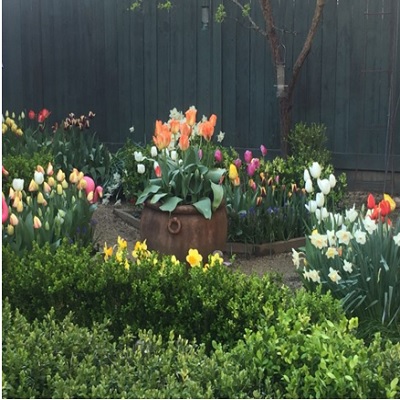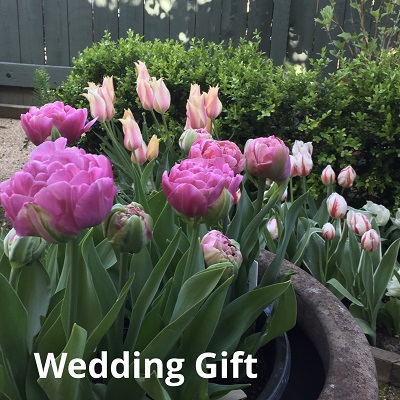Larry Paulger takes his work home with him and, in this case, it’s a beautiful arrangement.
Original article by PJ Bremier published 4/19/2021 in the Marin IJ
Paulger, a Novato resident and owner of Paulger’s Plants & Bulbs, is a bulb and young plant broker who sells to botanical gardens across the country and wholesale nurseries mostly along the West Coast.
The annuals he sells fall primarily in what he humorously calls “the usual suspects” — impatiens, petunias and snapdragons. He also brokers perennials such as hostas and bush peonies, hardy garden ferns and flower bulbs, the bulk of which are tulips.
 “Tulips represent $71 million in the United States cut flower market,” says Paulger, citing a recent trade magazine report. “They’re the most popular bloom and represent twice the sales of the next category, lilies, at $34 million in U.S. sales.” The next best category would be daffodils, he adds.
“Tulips represent $71 million in the United States cut flower market,” says Paulger, citing a recent trade magazine report. “They’re the most popular bloom and represent twice the sales of the next category, lilies, at $34 million in U.S. sales.” The next best category would be daffodils, he adds.
“Tulips and daffodils make a terrific garden,” he says.
His own garden is replanted annually with at least 600 bulbs, including his favorites, such as Olympic Flame tulips and selections from the Impressions collection, along with Pipit, Lemon Glow and St. Patrick’s Day daffodils.
For flower bulb enthusiasts, his bulbs can be seen in the fairly large permanent daffodil display near Filoli’s visitor center in Woodside, and more locally, in a median strip on Sunset Parkway in Novato that he’s adopted for the past three years.
The median strip, along with his own garden, are where he trials the success of his bulbs in order to help his clients learn more about bulbs that grow well in our area’s climate.
“It’s too warm at night along the coast for daffodils to perennialize here,” he says. He’s looking for the ones that will. “Generally, they won’t repeat although (a micro) location can make a difference.”
 Daffodils are divided into divisions such as Trumpet (i.e. King Alfred or Dutch Master), Large Cup (i.e. Carlton) and Small Cup (i.e. Barrett Browning).
Daffodils are divided into divisions such as Trumpet (i.e. King Alfred or Dutch Master), Large Cup (i.e. Carlton) and Small Cup (i.e. Barrett Browning).
Daffodils are a great deer-proof choice for dry locations.
The division that does perennialize well in Marin are jonquils and cyclamineus.
“They’re the best bet in unirrigated spots, which is one of the reasons they do well in median strips,” he says. Another good reason is that deer are not attracted to them.
Here are Paulger’s top tips, gathered mostly from colleagues who work for botanical gardens around the country, on growing tulips and daffodils:
- “Bulbs are native to places that have hot dry summers. They grow on hillsides where water from winter rain drains quickly. The bulb helps the plant get through that dry summer.”
- “Tulips have three flowering periods, early mid-season and late season. The late season varieties do best in our climate. The most skillful gardeners know how to use varieties from all three periods.” He suggests people visit the bulb gardens at Filoli to see all types of tulips.
- “Tulips and daffodils go dormant in the summer and do not want heavy watering. As soil temperatures drop the bulbs start putting out new roots.”
- “During the winter, tulips need about a ½-inch of rain per week.”
- “For our climate we have best results using the Darwin Hybrids and Lily Flowered Tulips. Darwin Hybrids have very large flowers and strong stems.”
- “Full sun is hard on the flowers and shortens the duration of flowering time. You will enjoy a longer display of garden color when they are grown in filtered light to full afternoon shade.”
- “Grow them away from sources of heat. Pots should be stored away from your house until they are ready to flower. Then they can be moved to doorsteps. Grow them in beds on the outer perimeter of your home.”
Larry Paulger’s Novato garden features 600 bulbs of tulips and daffodils.
- “Tulips are heavy feeders. Fertilize at planting with 9-9-6 bulb fertilizer. High nitrogen fertilizers will cause fast soft growth and the plants will have weak stems and the flowers will not have sufficient wind resentence and may fall over.”
- “Mix the fertilizer with the soil below the root zone, then add a little soil before planting the bulbs.”
- “I plant after the hot weather of September has passed, usually between mid-October and Thanksgiving.”
- “Cover the bulbs with 6 to 8 inches of soil to keep the sun from warming the soil too deeply and causing heat stress. Heat stress makes the flowers look like Easter eggs coming up out of the ground. The stems will usually, but not always, elongate and look OK.”
- “Cut the flowers to take inside just as the bud begins to show color.”.
- “Crop rotation prevents disease problems. Rotate tulips to new beds after two seasons and replant your beds after a year or two.”
 Show off
Show off
Since so many of the popular home tours are off the calendar this year, please consider this your invitation to share with fellow readers the images and description of your garden or newly designed or remodeled Marin home.
Please send an email describing either one, what you love most about it and a photograph or two. I will post the very best ones in upcoming columns. Your name will be published and you must be over 18 years old and a Marin resident.
Don’t-miss events
- Learn how to create clones of your favorite wood plants such as lavender, rosemary and fuchsias during a one-hour hands-on workshop at Monte-Bellaria di California at 3518 Bloomfield Road in Sebastopol. Seminars will be at 10 a.m. April 18 or 25. The fee is $25, plus booking charge, and includes coffee, snack and a cutting to take home. Call 707-829-2645 or go to monte-bellaria.com.
- Join the second annual Earth Day “Mushroom Hunt” in San Rafael from 10 a.m. to noon April 24. Pick your favorite free cork “mushroom” from the sidewalk in front of 26 Marin St. at Clorinda and “plant” them in your neighborhood, along trails, or in your own front yard for others to admire. See posted flyers in the neighborhood for details.
PJ Bremier writes on home, garden, design and entertaining topics every Saturday. She may be contacted at P.O. Box 412, Kentfield 94914, or at pj@pjbremier.com.

